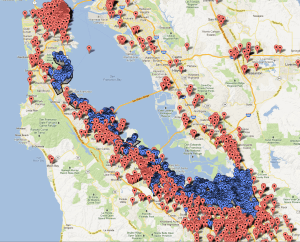EAT Club, a Palo Alto-based food delivery service launched in fall 2010, has raised $5 million in Series A funding in a round led by August Capital. Also participating in the round were First Round Capital, Siemer Ventures, Great Oaks Venture Capital, Launch Capital, Tekton Ventures, Mark Vadon (Zulily and Blue Nile co-founder) and other angel investors.
As a result of the new funding, Howard Hartenbaum of August Capital will now join the company’s board of directors. EAT Club had previously raised $1.5 million in seed funding led by First Round in summer 2011.
CEO Frank Han admits that the market for food delivery startups has become somewhat “frothy” as of late. There are a number of competitors in this broader food delivery space, including menu aggregators like GrubHub and Seamless, B2B-focused caterers like Cater2.me, Waiter.com and ZeroCater, Postmates’ Get It Now, and even new entrant Chewse, which also this week announced a $1 million seed round for its own lunch catering ambitions.
But Han explains that EAT Club is different for a few reasons: It’s trying to build a consumer-facing brand, not a B2B service; it’s curating menus from local restaurants to offer new dish selections daily; it works with restaurants that do and don’t deliver themselves; and it’s aiming to take the service national.
However, EAT Club, as it stands today does sound a lot like Chewse, in terms of the menu-curation aspect. Like Chewse, it also works with various “foodie” experts who team up with the restaurants to find the best dishes for local customers. That said, it’s not solely focused on signing contracts with businesses to be the lunch provider for the companies. Of its “tens of thousands” of registered users, EAT Club has around 100 companies where that’s the case.
“Our vision is to make great food accessible to everybody,” says Han.
Han had joined the startup in September 2011 to help it grow and scale. Co-founders Kevin Yang and Rodrigo Santibanez had actually launched EAT Club right after graduating from Stanford. “They were trying to solve the problem of ‘crappy lunch,'” Han explains. “So they started this business of lunch ordering for office people.”
EAT Club hasn’t done a lot of press, the CEO tells us. Instead, it wanted to focus on building up the business first. Since he joined, things have been picking up steam. “We’ve been growing like crazy. Since the middle of last year, we’re double-digit, month-over-month growth,” Han says.
He declined to provide hard numbers in terms of order volume, saying that would tip its hand as to revenue. Generally speaking, he places revenue below the big menu aggregators, but above some of the newer, seed-funded startups.
 Currently, EAT Club targets consumers in the Bay Area (on the peninsula, mainly), offering delivery to 1,500 companies, with customers who have included Chegg, Bloomreach, Gunderson Dettmer, and IMVU. Each day, members receive an email with 10 to 15 lunch suggestions at $8-$10 each. They can order in the morning, or up to five days in advance, and receive their lunch by 11:30 to 12:30 pm. Meeting delivery times is important to EAT Club, which touts its 99.7 percent “on time” rate.
Currently, EAT Club targets consumers in the Bay Area (on the peninsula, mainly), offering delivery to 1,500 companies, with customers who have included Chegg, Bloomreach, Gunderson Dettmer, and IMVU. Each day, members receive an email with 10 to 15 lunch suggestions at $8-$10 each. They can order in the morning, or up to five days in advance, and receive their lunch by 11:30 to 12:30 pm. Meeting delivery times is important to EAT Club, which touts its 99.7 percent “on time” rate.
The system is currently most popular on the web, though it offers an iOS application for orders, as well. The average customer orders 1.5-2 times per week, and 50 percent of those who are active in the month return the following month to order again.
Unlike when you order from a pizza chain, for example, EAT Club’s operational model involves technology on the backend for order processing and routing, which allows its network of part-time drivers to deliver a hundred meals at a time, going from one company to the next. It also relies on direct outreach to businesses and word-of-mouth referral programs to help acquire customers.
 The plan is to use the funding to hire people to help with marketing and expansion and, as always, this startup needs more engineers. Eat Club has 20-some, full-time employees and wants to add about 10 more by the end of the year.
The plan is to use the funding to hire people to help with marketing and expansion and, as always, this startup needs more engineers. Eat Club has 20-some, full-time employees and wants to add about 10 more by the end of the year.
EAT Club will open its next market this fall, but Han declined to say where for competitive reasons.
On the product side, the focus will be on refining the mobile app on iOS rather than building for Android. The plan is to use more push notifications in order to track demand and remind users to order. As Han explains, on mobile, EAT Club could ping users who didn’t place an order that morning, allowing them to place their order later in the day – closer to lunch than what EAT Club is capable of now.
“We want to be closer to on-demand. If we get closer to on-demand, the market gets even bigger,” says Han. “You’ll see us getting more aggressive with iOS in the next few months. We’ve already started,” he adds.
Interested Bay Area users can sign up for EAT Club here.

